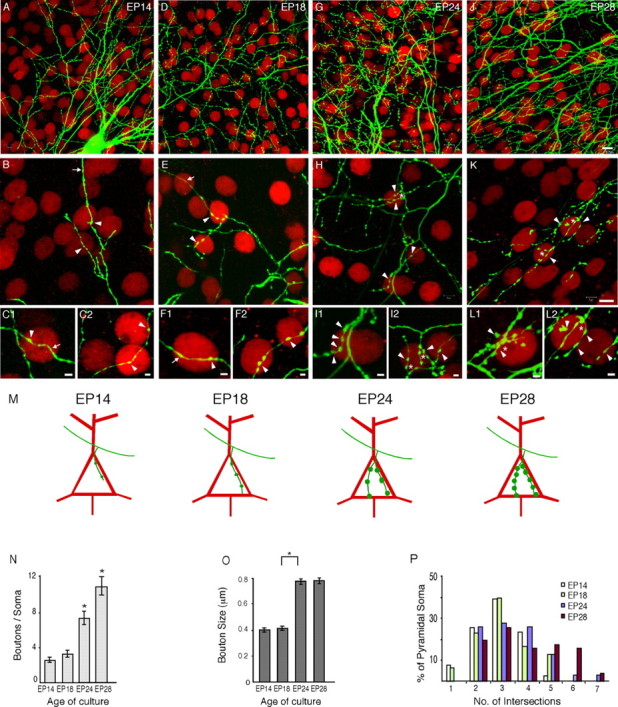Figure 6.

Formation of perisomatic synapses proceeds in cortical organotypic cultures. A-C, At EP14, many axon branches have reached and surrounded pyramidal cell somata but contain only one or two putative boutons around each soma (arrowheads). Note long segment of axons devoid of boutons (arrow). D-F, At EP18, more pyramidal cell somata are likely innervated (D), but basket axon terminal branch complexity and bouton density around each pyramidal cell soma (arrowheads in E and F) are similar to those at EP14. G-I, At EP24, one or more axonal branches extend around a pyramidal cell soma to form a terminal fork (asterisk), along with an increase in the number and size of boutons (arrowheads in H and I). J-L, At EP28, there is an additional increase in bouton number (arrowheads) within terminal forks, which in some cases resemble a basket (asterisk). Scale bar: (top) A, D, G, J, 15 μm; (middle) B, E, H, K, 10 μm; (bottom) C, F, I, L, 2 μm. M, A schematic summarizing the stereotyped process of perisomatic synapse formation. N, Quantification of the developmental increase of basket cell presynaptic boutons density around pyramidal cell somata. The bouton number around each pyramidal cell soma is quantified by Reverse Three-Dimensional Sholl analysis within a 7 μm Sholl sphere from the center of its nucleus. Bouton density increases significantly between EP18 and EP28 (1-way ANOVA, post hoc Dunn's test; p < 0.05). O, Average bouton diameter, measured perpendicular to the axon, at different developmental ages. Bouton size increases significantly between EP18 and EP24 (one-way ANOVA, post hoc Dunn's test; p < 0.05). P, Developmental increase of basket axon terminal branch complexity around pyramidal cell somata. Pyramidal cells at different ages are grouped according to the average number of intersections between a 7 μm Sholl sphere from the center of their nuclei and basket axon branches surrounding them. At EP24 and EP28, pyramidal cell somata are surrounded by more complex terminal branches than cells from EP18 and EP14, as indicated by the appearance of pyramidal cell groups showing a higher number of intersections.
